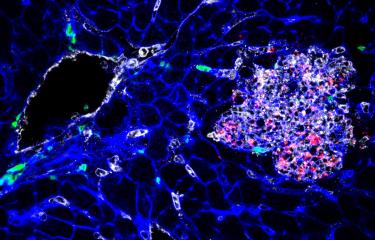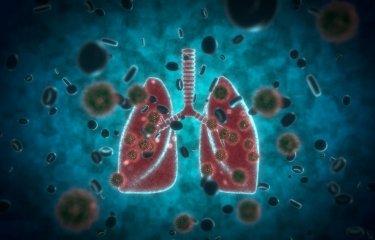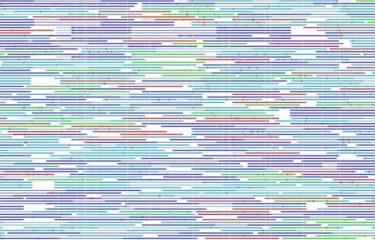By investigating the genome sequence of an international collection of strains of Listeria monocytogenes bacteria, two Institut Pasteur scientists, Sylvain Brisse and Marc Lecuit, have helped improve our understanding of how different Listeria strains circulate across the world. Their method of typing strains using high-throughput sequencing signals a new era for the global monitoring of listeriosis cases.
Listeriosis is a disease caused by the foodborne bacterium Listeria monocytogenes (Lm). Teams led by Institut Pasteur scientists Sylvain Brisse and Marc Lecuit used high-throughput sequencing to analyze the whole genome of hundreds of strains of Listeria monocytogenes. Sylvain Brisse leads a research group in the Microbial Evolutionary Genomics Unit directed by Eduardo Rocha, and Marc Lecuit is Head of the Biology of Infection Unit (Institut Pasteur – Inserm U1117). The Institut Pasteur's collaboration with prestigious health research institutes* from the United States, the United Kingdom, Canada, Denmark and France for this study indicates the importance of this research, which mark a turning point in the field.
"We analyzed almost 1,700 strains from United States, the United Kingdom, Canada, Denmark and France," explained the scientists. With unprecedented precision, they investigated the population diversity of these bacteria: "We established the precise structure of the Listeria monocytogenes population, calculated the evolutionary rate of the strains, demonstrated that they circulate worldwide, and revealed the extent of heterogeneity in the virulence and genomic characteristics of these strains," reported the scientists.
A new Listeria classification
The highly innovative aspect of this study was the scientists' decision to classify the bacteria into several subtypes, some of which are more likely to cause disease. "This is a major step forward in terms of basic research and public health," continued Marc Lecuit. "The technique for typing Listeria strains that we have developed is set to become the new standard, with whole-genome analysis of strains" when a case of listeriosis emerges somewhere in the world or contaminated food is detected. "We established a standardized nomenclature for strains that can be used to identify them with great precision. This will enable public health agencies to communicate effectively during outbreaks and to determine their geographical provenance and foodborne cause in real time," pointed out Sylvain Brisse. "Our investigation into around fifty recent epidemics also enabled us to calibrate our analysis method with a view to the detection of future epidemics," continued the scientist.

Paving the way for faster, more precise and internationally reproducible comparative analysis
In the event of a listeriosis outbreak, comparative analysis is vital and must be performed as quickly as possible, which is what makes this technological breakthrough all the more important. Since Listeria bacteria contaminate food products, entire batches of food can be affected, and health authorities have a responsibility to react immediately to avoid dangerous epidemics. These decisions to take public health action are based on the results of analyses carried out by recognized laboratories such as the National Reference Center for Listeria at the Institut Pasteur**, attached to Marc Lecuit's unit, in collaboration with the French Public Health Agency.
"By analyzing our 1,700 samples, we were able to obtain a very precise picture of the Listeria population at global level," explained Sylvain Brisse. "We published all these data on a website hosted by the Institut Pasteur, accessible to all international centers of expertise, with a very straightforward classification system which facilitates the comparative analysis of strains." Previously, when a case of listeriosis emerged, the sample was sent to the nearest center of expertise, which would have to contact other laboratories across the world to determine the provenance of the strain. "But current data only provide a general genetic profile of the bacterial strain, and one which is incomplete, because up to now scientists only analyzed a tiny part of the genome," explained Marc Lecuit. This meant that outbreaks were sometimes poorly detected and therefore poorly controlled.
A technological breakthrough with PIBnet
What made the difference in this study was the use of high-throughput sequencing to analyze the strains, in conjunction with a sophisticated data analysis strategy. This technological breakthrough in public health surveillance has been made possible at the Institut Pasteur by the new PIBnet (Pasteur International Bioresources Network) program.
Listeriosis is a disease that mostly causes gastrointestinal problems, but in some cases infection can be more severe. In high-risk individuals such as pregnant women, newborns, the elderly and people with reduced immunity (undergoing medical treatment such as immunotherapy or corticosteroids or suffering from cancer, diabetes, etc.), listeriosis can lead to septicemia, infection of the central nervous system and even death. In the European Union, approximately 1,676 human cases were reported in 2011, but it is likely that many more cases went unreported (source: ECDC – European Center for Disease Prevention and Control).
* Centers for Disease Control and Prevention, Atlanta (USA); Statens Serum Institut, Copenhagen (Denmark); Public Health England, London (United Kingdom); Public Health Agency of Canada, Winnipeg (Canada); Public Health France, Saint-Maurice (France); Institut Pasteur, National Reference Center and World Health Organization Collaborating Center for Listeria, Paris (France).
** The Listeria CNR is attached to the Biology of Infection Unit, which also hosts the WHO Collaborating Center for Listeria.
Source
Whole genome-based population biology and epidemiological surveillance of Listeria monocytogenes, Nature Microbiology, 10 octobre.
Alexandra Moura1,2,3,4,5, Alexis Criscuolo6, Hannes Pouseele7, Mylene M. Maury1,2,3,4,5,8, Alexandre Leclercq1,2, Cheryl Tarr9, Jonas T. Bjorkman10, Timothy Dallman11, Aleisha Reimer12, Vincent Enouf13, Elise Larsonneur4,6,14, Heather Carleton9, Helene Bracq-Dieye1,2, Lee S. Katz9, Louis Jones6, Marie Touchon4,5, Mathieu Tourdjman15, Matthew Walker12, Steven Stroika9, Thomas Cantinelli1, Viviane Chenal-Francisque1, Zuzana Kucerova9, Eduardo P. C. Rocha4,5, Celine Nadon12, Kathie Grant11, Eva M. Nielsen10, Bruno Pot7, Peter Gerner-Smidt9, Marc Lecuit1,2,3,16,*, Sylvain Brisse4,5,*
1 Institut Pasteur, National Reference Centre and World Health Organization Collaborating Center for Listeria, Paris, France;
2 Institut Pasteur, Biology of Infection Unit, Paris, France;
3 Inserm U1117, Paris France;
4 Institut Pasteur, Microbial Evolutionary Genomics Unit, Paris, France;
5 CNRS, UMR 3525, Paris, France;
6 Institut Pasteur – Hub Bioinformatique et Biostatistique – C3BI, USR 3756 IP CNRS – Paris, France;
7 Applied-Maths, Sint-Martens-Latem, Belgium;
8 Paris Diderot University, Sorbonne Paris Cite, Cellule Pasteur, Paris, France;
9 Centers for Disease Control and Prevention, Atlanta, Georgia, United States;
10 Statens Serum Institut, Copenhagen, Denmark;
11 Public Health England, London, United Kingdom;
12 Public Health Agency of Canada, Winnipeg, Canada;
13 Institut Pasteur, Pasteur International Bioresources network (PIBnet), Mutualized Microbiology Platform (P2M), Paris, France;
14 CNRS, UMS 3601 IFB-Core, Gif-sur-Yvette, France;
15 Public Health France, Saint-Maurice, France;
16 Paris Descartes University, Sorbonne Paris Cite, Institut Imagine, Necker-Enfants Malades University Hospital, Division of Infectious Diseases and Tropical Medicine, APHP, Paris, France.
Mis à jour le 17/10/2016







